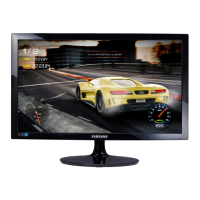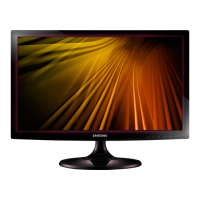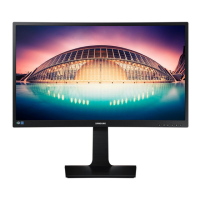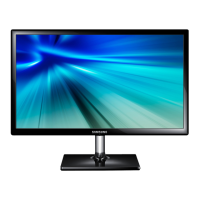Do you have a question about the Samsung S24D330H and is the answer not in the manual?
Ensure adequate space around the product for ventilation to prevent overheating and damage.
Important safety warnings to reduce the risk of electric shock, injury, or damage.
Explains warning symbols used in the manual indicating potential hazards or important information.
Advice on storing the product, particularly regarding high-glossy models and humidifiers.
Guidelines for cleaning the monitor panel and exterior to prevent scratches and damage.
Crucial safety instructions for handling power cords, plugs, and sockets to prevent hazards.
Warnings and precautions to follow during product installation to ensure safety and prevent damage.
Important warnings and guidelines for safe and proper operation of the product.
Identifies and describes the physical components of the monitor, including frontal buttons and their functions.
Explains the meaning and function of various icons used in the OSD menu and for controls.
Details the ports located on the back of the product and their respective connections.
Instructions on how to adjust brightness and contrast directly from the initial screen without accessing the OSD menu.
Guide on how to adjust the tilt angle of the monitor for optimal viewing position.
Information on how to use an anti-theft lock to secure the product in public places.
Step-by-step instructions for assembling and securely attaching the monitor stand to the product.
Instructions on how to safely detach and remove the monitor stand from the product.
Guidelines for maintaining correct posture while using the monitor for comfort and health.
Instructions on how to install the necessary drivers for optimal product performance and features.
Information on how to set the monitor to its optimum resolution for the best picture quality.
Important steps to perform before connecting any source device to ensure proper setup and prevent damage.
Detailed instructions for connecting the monitor to a PC using a D-SUB analog cable.
Steps for connecting the monitor to a source device using an HDMI cable.
Instructions for connecting the monitor to a source device using an HDMI-DVI cable.
Guide on how to connect the monitor to a power source using the provided AC/DC adapter.
Adjusts the general brightness level of the picture for optimal viewing.
Adjusts the contrast between objects and the background for clearer image definition.
Enhances or softens the outlines of objects to make the picture clearer or softer.
Configures screen settings optimized for playing games on consoles or PCs.
Provides optimum picture quality settings suitable for various environments and preferences.
Adjusts settings to obtain optimum picture quality based on the user's viewing angle.
Enhances picture details and vividness, especially on low-resolution images.
Allows changing the picture size to fit different aspect ratios or screen modes.
Adjusts image quality for HDMI connections, specifically contrast and color degradation.
Accelerates panel response rate for more vivid and natural video playback.
Adjusts the horizontal and vertical position of the screen image.
Adjusts the screen frequency in Analog mode.
Fine-tunes the screen to obtain a vivid picture in Analog mode.
Adjusts the intensity of the red color component in the picture.
Adjusts the intensity of the green color component in the picture.
Adjusts the intensity of the blue color component in the picture.
Adjusts the general color tone of the picture by selecting different temperature settings.
Adjusts the mid-range brightness (Gamma) for the picture.
Sets the language for the onscreen display menu.
Adjusts the horizontal and vertical position of the on-screen display (OSD) menu.
Sets the time after which the OSD menu will automatically disappear when not in use.
Adjusts the transparency level of the menu windows.
Returns all product settings to their default factory configurations.
Reduces power consumption by controlling the electric current used by the monitor panel.
Allows setting a timer for the product to automatically power off after a specified period.
Sets the display mode for PC or AV input to optimize picture size and quality.
Controls the response rate of buttons when pressed repeatedly.
Selects the method (Auto or Manual) for recognizing the input signal.
Displays current input source, frequency, and resolution information.
Enables users to partition the monitor screen into multiple sections for multitasking.
Steps to take and tests to perform before contacting customer support for assistance.
Guide on how to use the product's self-diagnosis test function to check normal operation.
Explains how to check and set the correct resolution and frequency for optimal display.
Addresses common installation problems when connecting the product to a PC.
Troubleshoots common screen display problems like blank screens or distorted images.
Explains the "Not Optimum Mode" message and how to resolve resolution/frequency compatibility issues.
Provides solutions for choppy video playback issues, often related to optimization.
Addresses issues originating from the source device, such as beeping sounds during booting.
Frequently asked questions and answers regarding frequency, resolution, and power-saving mode settings.
Provides general technical specifications of the monitor, including model name, size, and display area.
A table listing standard signal modes, resolutions, and frequencies supported by the monitor.
Outlines cases where service charges may apply, even if the product is under warranty.
Lists situations that are not considered product defects and may incur service fees.
Details product damages caused by mishandling, incorrect usage, or unauthorized repair.
Covers other situations like natural disasters or consumable component failures that may affect service charges.
Ensure adequate space around the product for ventilation to prevent overheating and damage.
Important safety warnings to reduce the risk of electric shock, injury, or damage.
Explains warning symbols used in the manual indicating potential hazards or important information.
Advice on storing the product, particularly regarding high-glossy models and humidifiers.
Guidelines for cleaning the monitor panel and exterior to prevent scratches and damage.
Crucial safety instructions for handling power cords, plugs, and sockets to prevent hazards.
Warnings and precautions to follow during product installation to ensure safety and prevent damage.
Important warnings and guidelines for safe and proper operation of the product.
Identifies and describes the physical components of the monitor, including frontal buttons and their functions.
Explains the meaning and function of various icons used in the OSD menu and for controls.
Details the ports located on the back of the product and their respective connections.
Instructions on how to adjust brightness and contrast directly from the initial screen without accessing the OSD menu.
Guide on how to adjust the tilt angle of the monitor for optimal viewing position.
Information on how to use an anti-theft lock to secure the product in public places.
Step-by-step instructions for assembling and securely attaching the monitor stand to the product.
Instructions on how to safely detach and remove the monitor stand from the product.
Guidelines for maintaining correct posture while using the monitor for comfort and health.
Instructions on how to install the necessary drivers for optimal product performance and features.
Information on how to set the monitor to its optimum resolution for the best picture quality.
Important steps to perform before connecting any source device to ensure proper setup and prevent damage.
Detailed instructions for connecting the monitor to a PC using a D-SUB analog cable.
Steps for connecting the monitor to a source device using an HDMI cable.
Instructions for connecting the monitor to a source device using an HDMI-DVI cable.
Guide on how to connect the monitor to a power source using the provided AC/DC adapter.
Adjusts the general brightness level of the picture for optimal viewing.
Adjusts the contrast between objects and the background for clearer image definition.
Enhances or softens the outlines of objects to make the picture clearer or softer.
Configures screen settings optimized for playing games on consoles or PCs.
Provides optimum picture quality settings suitable for various environments and preferences.
Adjusts settings to obtain optimum picture quality based on the user's viewing angle.
Enhances picture details and vividness, especially on low-resolution images.
Allows changing the picture size to fit different aspect ratios or screen modes.
Adjusts image quality for HDMI connections, specifically contrast and color degradation.
Accelerates panel response rate for more vivid and natural video playback.
Adjusts the horizontal and vertical position of the screen image.
Adjusts the screen frequency in Analog mode.
Fine-tunes the screen to obtain a vivid picture in Analog mode.
Adjusts the intensity of the red color component in the picture.
Adjusts the intensity of the green color component in the picture.
Adjusts the intensity of the blue color component in the picture.
Adjusts the general color tone of the picture by selecting different temperature settings.
Adjusts the mid-range brightness (Gamma) for the picture.
Sets the language for the onscreen display menu.
Adjusts the horizontal and vertical position of the on-screen display (OSD) menu.
Sets the time after which the OSD menu will automatically disappear when not in use.
Adjusts the transparency level of the menu windows.
Returns all product settings to their default factory configurations.
Reduces power consumption by controlling the electric current used by the monitor panel.
Allows setting a timer for the product to automatically power off after a specified period.
Sets the display mode for PC or AV input to optimize picture size and quality.
Controls the response rate of buttons when pressed repeatedly.
Selects the method (Auto or Manual) for recognizing the input signal.
Displays current input source, frequency, and resolution information.
Enables users to partition the monitor screen into multiple sections for multitasking.
Steps to take and tests to perform before contacting customer support for assistance.
Guide on how to use the product's self-diagnosis test function to check normal operation.
Explains how to check and set the correct resolution and frequency for optimal display.
Addresses common installation problems when connecting the product to a PC.
Troubleshoots common screen display problems like blank screens or distorted images.
Explains the "Not Optimum Mode" message and how to resolve resolution/frequency compatibility issues.
Provides solutions for choppy video playback issues, often related to optimization.
Addresses issues originating from the source device, such as beeping sounds during booting.
Frequently asked questions and answers regarding frequency, resolution, and power-saving mode settings.
Provides general technical specifications of the monitor, including model name, size, and display area.
A table listing standard signal modes, resolutions, and frequencies supported by the monitor.
Outlines cases where service charges may apply, even if the product is under warranty.
Lists situations that are not considered product defects and may incur service fees.
Details product damages caused by mishandling, incorrect usage, or unauthorized repair.
Covers other situations like natural disasters or consumable component failures that may affect service charges.
| 3D | No |
|---|---|
| Panel type | TN |
| Screen shape | Flat |
| Display diagonal | 24 \ |
| Display technology | LED |
| Native aspect ratio | 16:9 |
| Maximum refresh rate | 60 Hz |
| Viewing angle, vertical | 160 ° |
| Contrast ratio (dynamic) | 1000000:1 |
| Contrast ratio (typical) | 1000:1 |
| Display brightness (min) | 200 cd/m² |
| Display number of colors | 16.78 million colors |
| Viewing angle, horizontal | 170 ° |
| Display brightness (typical) | 250 cd/m² |
| Supported graphics resolutions | 1920 x 1080 (HD 1080) |
| AC input voltage | 100 - 240 V |
| External power adapter | Yes |
| Energy efficiency scale | A to G |
| Power consumption (max) | 30 W |
| Power consumption (off) | 0.3 W |
| Power consumption (standby) | - W |
| Power consumption (typical) | 23 W |
| Samsung Magic Function | MagicAngle, MagicBright, MagicUpscale |
| Power consumption (DPMS) | 0.5 W |
| Windows operating systems supported | Windows 10, Windows 10 Education, Windows 10 Education x64, Windows 10 Enterprise, Windows 10 Enterprise x64, Windows 10 Home, Windows 10 Home x64, Windows 10 IOT Core, Windows 10 Pro, Windows 10 Pro x64 |
| Operating temperature (T-T) | 10 - 40 °C |
| Operating relative humidity (H-H) | 10 - 80 % |
| Cables included | HDMI |
| VESA mounting | - |
| Tilt angle range | -1 - 20 ° |
| Package type | Box |
| Package depth | 408 mm |
| Package width | 635 mm |
| Package height | 111 mm |
| Package weight | 4400 g |
| Certification | Windows 10 |
| Product color | Black |
| Depth (with stand) | 197 mm |
|---|---|
| Width (with stand) | 569 mm |
| Height (with stand) | 417.2 mm |
| Weight (with stand) | 3150 g |
| Depth (without stand) | 53.9 mm |
| Height (without stand) | 342.1 mm |
| Weight (without stand) | 2800 g |












